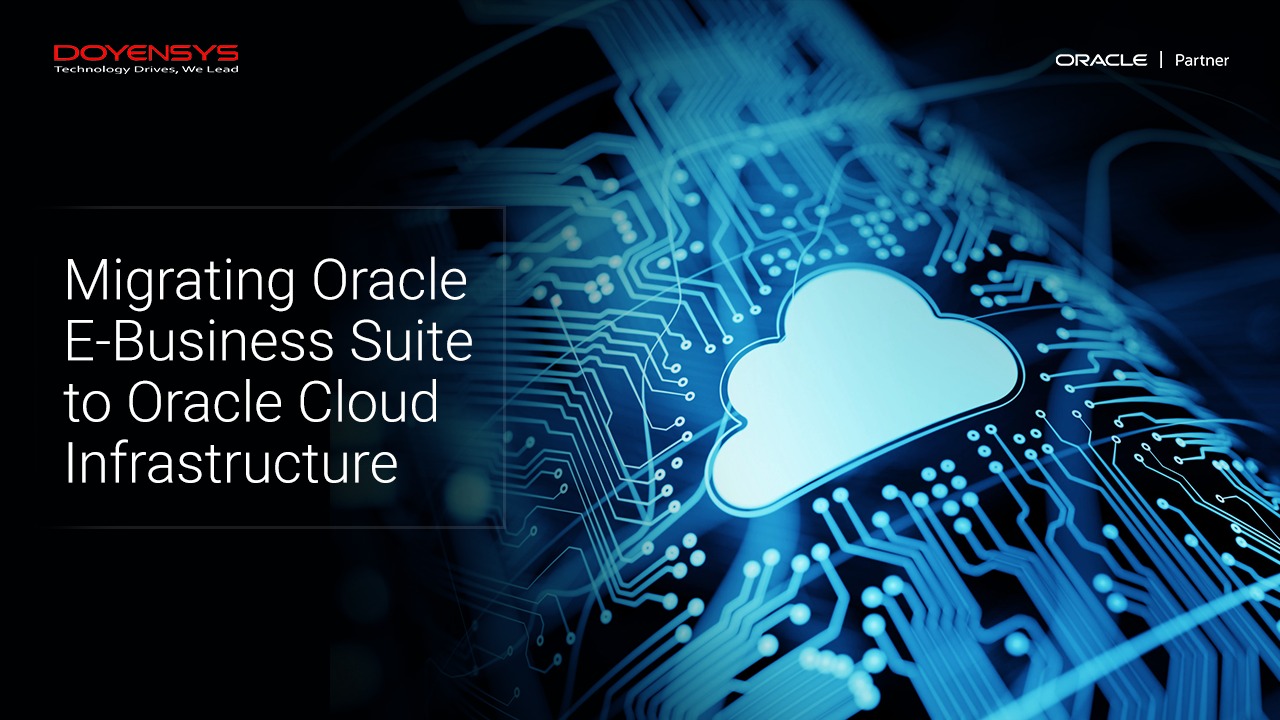
This blog post offers insights into the optimal options and best practices for migrating your Oracle E-Business Suite (EBS) from on-premises to Oracle Cloud Infrastructure (OCI), harnessing the capabilities of OCI’s Infrastructure-as-a-Service (IaaS) and Platform-as-a-Service (PaaS) offerings. It delves into the primary implementation considerations and the essential requirements to be addressed during the migration process. Additionally, this article provides an overview of OCI’s key features, cloud services support, third-party integrations, and best deployment practices that align with your application requirements. We’ll also explore how Doyensys, a reputable Oracle Service Provider, can assist your team in achieving a seamless migration and ongoing support for your EBS environment.
Assumptions
We assume that your organization currently utilizes an on-premises setup of Oracle E-Business Suite for functions such as account receivables, order management, procurement, advanced supply chain planning, manufacturing, logistics, and financials. Your E-Business Suite implementation may have undergone customization to tailor it to your specific needs and might be integrated with other applications to enhance daily operations.
Challenges of On-Premise EBS
Many organizations face challenges in maintaining EBS in a static, on-premise environment, which limits its adaptability to the rapidly changing business landscape. Fortunately, migrating your existing EBS setup to a modern cloud solution, such as IaaS or PaaS, presents an opportunity to unlock its full potential. Oracle E-Business Suite is expected to remain supported through Oracle Premier Support until 2033. By engineering your EBS on an IaaS/PaaS platform, you gain control over security, scalability, reliability, performance, and availability, ensuring your business model remains robust.
Competitive Advantages of Operating EBS in OCI
Migrating your EBS to Oracle Cloud Infrastructure offers numerous competitive advantages, including:
Lower Total Cost of Ownership (TCO): Achieve a 38% reduction in TCO compared to on-premises deployments and a 44% reduction compared to Amazon Web Services (AWS).
Capital Expenditure Reduction: Streamline capital expenditure (CAPEX) by optimizing data center efficiency, eliminating server hardware costs, and leveraging cloud flexibility.
Enhanced Performance: Experience a 30% performance boost and 2-10 times faster reporting.
High Availability: Ensure high availability with a Recovery Time Objective (RTO) of less than 4 hours and a Recovery Point Objective (RPO) of less than 4 hours.
Scalability: Leverage Oracle Real Application Clusters (RAC) or Oracle Database Exadata Cloud Service for scalable solutions.
Rapid Patching: Seamlessly update technology and apply patches.
Proactive Monitoring: Keep track of usage and costs through proactive monitoring.
Scalability: Enjoy near-instant scaling up or down to accommodate business growth or workload fluctuations.
Federated Identity: Integrate seamlessly with existing systems through federated identity support.
Compliance Simplification: Reduce audit duration and costs, as security and compliance overhead for IaaS are Oracle’s responsibility.
Operational Expenditure: Shift from large, irregular CAPEX expenditures to predictable operating expenditures (OPEX).
Pay-as-You-Go: Pay based on actual usage, offering cost flexibility.
License Flexibility: Bring your existing Oracle licenses to Oracle Cloud Infrastructure to maximize your investments.
Cloud Management Tools: Utilize cloud management tools, Identity and Access Management, Cost Management, and EBS Availability & Database Recoverability solutions.
Migration & Deployment Strategies
Selecting the right migration strategy for your EBS to OCI transition is crucial. Several methods are available, including:
Lift & Shift: Create a deployment architecture on OCI and then backup and restore your on-premises EBS on OCI or create a Data Guard Standby to minimize downtime during production switchover.
Move & Improve: Upgrade aspects of the environment, such as the operating system, database, and/or application software, to benefit from functional changes or new capabilities while ensuring supportability.
Oracle EBS Deployment Options on OCI
Choose from the following deployment options when moving your Oracle E-Business Suite to OCI:
IaaS Only: Deploy both the application and database tiers to Oracle Cloud Infrastructure Compute virtual machines.
IaaS + PaaS: Deploy the application tier to Oracle Cloud Infrastructure Compute virtual machines and the database tier to Oracle Database as a Service (DBaaS).
IaaS + Oracle RAC: Deploy the application tier to Oracle Cloud Infrastructure Compute virtual machines and the database tier to Oracle Real Application Clusters (RAC).
In today’s rapidly evolving business landscape, organizations are increasingly turning to the cloud to gain strategic advantages over on-premises solutions while optimizing resources. Oracle Cloud Services pave the way for a brighter future, and migrating your EBS to OCI opens doors to enhanced performance, scalability, availability, and cost savings.
While migrating from EBS to Oracle Cloud may seem daunting, the benefits are well worth the investment. Partnering with Doyensys for your migration simplifies the process, leveraging their extensive experience to help organizations of all sizes unlock the advantages and cost savings associated with migration.
Why Choose Doyensys?
Doyensys offers comprehensive technology and application management services, delivering cutting-edge solutions backed by over 17 years of experience, a portfolio of 40+ satisfied customers, and a team of 500+ professionals across India, the United States of America, Canada, and Mexico. Doyensys specializes in enterprise applications, including Oracle and ServiceNow. Learn more about Doyensys at doyensys.com.
Contact Doyensys today for a consultation and budgetary pricing by visiting https://doyensys.com/contact/.
